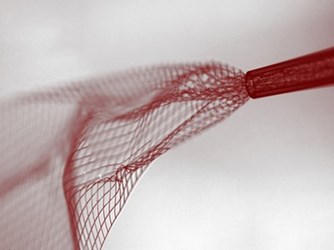Injectable Electronics Could Treat Brain Damage, Disease

A multidisciplinary team of scientists at Harvard University has developed an injectable mesh laced with electrodes that can unfurl at a targeted site within the brain and record neural activity. If further clinical testing proves the technology safe, the researchers envision the electronic mesh being used to treat neurodegenerative disorders, such as Parkinson’s disease, or brain damage, such as that caused by a stroke.
The sub-millimeter-thick, macroporous mesh is made of nanowires that are overlaid with an organic polymer, a combination that is “one million times more flexible than any state-of-the-art electronics and (has) subcellular feature sizes,” said research leader Charles Leiber, a chemist at Harvard, in a press release.
Leiber’s team introduced the mesh in 2012, using it as a scaffold to grow cardiac and nerve tissue during a series of in vitro experiments. In a study published in Nature Materials, the researchers showed that they could monitor electrical signals from the tissue, allowing them to test tissue response to series of drugs.
Encouraged by its in vitro experiments, Leiber’s team looked for a way to study the mesh in a living brain. Because the mesh is extremely flexible, the team endeavored to draw it into a syringe and inject it into a mouse brain through a tiny hole drilled at the top of the mouse’s skull.
The team’s most recent study, published in Nature Nanotechnology, determined that the mesh could be injected using a needle as small as 100 μm and that, as the mesh unfolded, individual brain cells arranged themselves around it. The studies found that the mesh could cohabitate with the brain tissue while provoking no immune response over five weeks of observation.
“This opens up a completely new frontier where we can explore the interface between electronic structures and biology,” said Leiber in a press release. “The idea of being able to precisely position and record from very specific areas, or even from specific neurons over an extended period of time — this could, I think, make a huge impact on neuroscience.”
The researchers believe the technology also could improve existing treatments for neurodegenerative disease or brain damage. According to Leiber, neural implants currently used for treatments like deep brain stimulation are much bigger and more rigid, and they frequently cause inflammation and have to be repositioned.
“But with our injectable electronics, it’s as if it’s not there at all. They’re what I call ‘neuro-phillic’ — they actually like to interact with neurons,” he said.
Rafael Yuste, director of the Neurotechnology Center at Columbia University, was not a part of the research but commented on the team’s findings in Nature.
“I think it’s great, a very creative new approach to the problem of recording from a large number of neurons in the brain,” said Yuste, who added that Harvard’s multidisciplinary approach was instrumental in “breaking through the major experimental and theoretical challenges that we have to conquer in order to understand how the brain works.”
